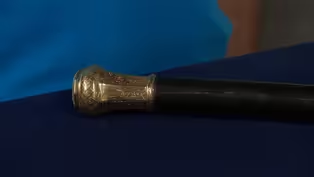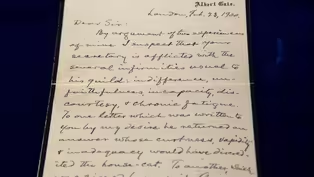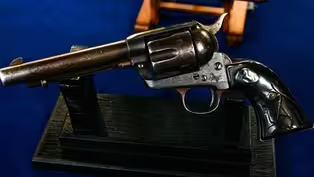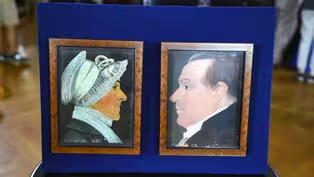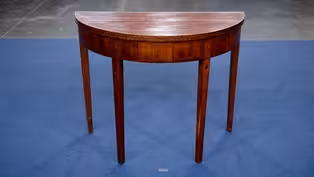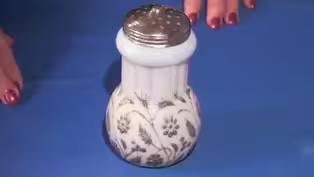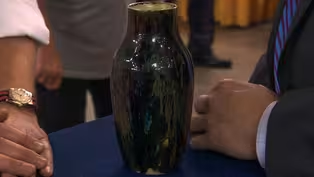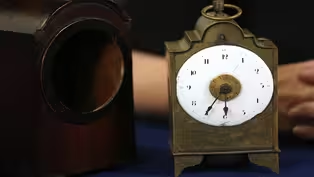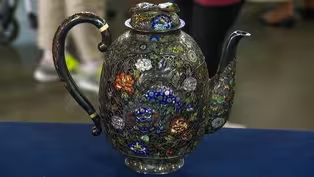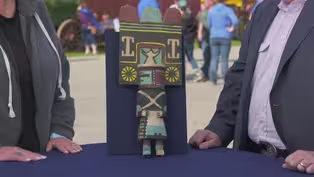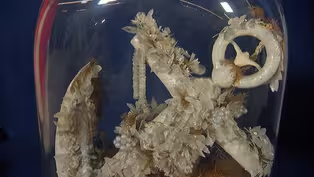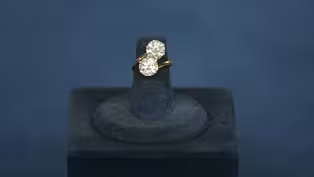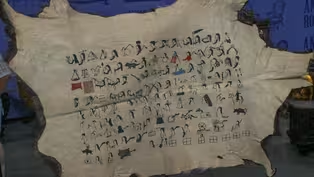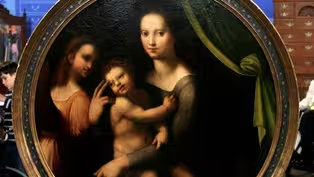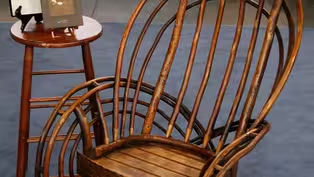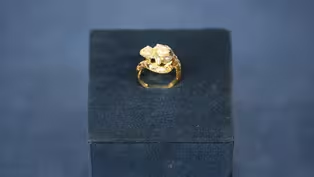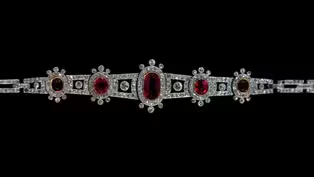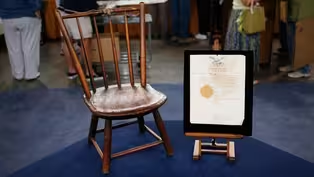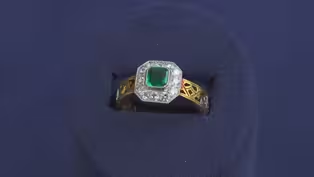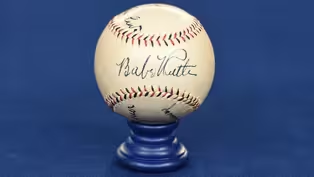
Appraisal: Ottoman Zarf, ca. 1875
Clip: Season 27 Episode 23 | 3m 47sVideo has Closed Captions
Appraisal: Ottoman Zarf, ca. 1875
Check out David Walker's appraisal of an Ottoman zarf from around 1875 in Did Grandma Lie?
Problems playing video? | Closed Captioning Feedback
Problems playing video? | Closed Captioning Feedback
Funding for ANTIQUES ROADSHOW is provided by Ancestry and American Cruise Lines. Additional funding is provided by public television viewers.

Appraisal: Ottoman Zarf, ca. 1875
Clip: Season 27 Episode 23 | 3m 47sVideo has Closed Captions
Check out David Walker's appraisal of an Ottoman zarf from around 1875 in Did Grandma Lie?
Problems playing video? | Closed Captioning Feedback
How to Watch Antiques Roadshow
Antiques Roadshow is available to stream on pbs.org and the free PBS App, available on iPhone, Apple TV, Android TV, Android smartphones, Amazon Fire TV, Amazon Fire Tablet, Roku, Samsung Smart TV, and Vizio.
Buy Now

ANTIQUES ROADSHOW DETOURS
Ever wondered what happens to the treasures featured on America’s beloved ANTIQUES ROADSHOW after the cameras leave town? Host Adam Monahan tracks down the juicy afterlives of your favorite finds from PBS’s hit series.Providing Support for PBS.org
Learn Moreabout PBS online sponsorshipGUEST: This is a mystery for me.
It is something that my husband and I inherited from his aunt.
Aunt Jean and her husband lived in Eureka, and they did a lot of collecting, and collected art glass, and this was in her collection.
APPRAISER: Mm-hmm.
GUEST: My husband called it a princess cup.
It was, like, one of his favorite things.
APPRAISER: Right.
GUEST: I believe he called it a princess cup because probably his aunt called it a princess cup.
APPRAISER: Okay.
GUEST: But we really know nothing-- I know nothing about it.
My husband, unfortunately, has passed away.
APPRAISER: I'm sorry.
GUEST: Today's his birthday, though, so I just feel like it's all meant to be, that we're here with one of his favorite things, and I'm going to find out what it truly is.
APPRAISER: And we are so fortunate to be able to see one of the things here today that he really, really did treasure, so thank you very much for bringing it to us.
You mentioned it was called colloquially the princess cup.
GUEST: Yes.
APPRAISER: Affectionately known.
The thing with this being a cup, of course, is that it has lots of holes in it.
GUEST: Yes, that's problematic.
APPRAISER: It's known as a zarf-- that's spelled Z-A-R-F.
It's a very unusual-sounding word, but it's actually coming from the Arabic for "envelope."
GUEST: Hm!
APPRAISER: Which basically, you know, to enclose something.
GUEST: Okay.
APPRAISER: And as we can see, because of the holes we mentioned a second ago, it's not going to work as a cup as it is.
GUEST: Correct.
APPRAISER: So it's going to have supported a glass that would have been used to hold coffee.
It's essentially a coffee-glass holder.
GUEST: Really!
APPRAISER: Yeah.
GUEST: Wow!
APPRAISER: Coffee was introduced into-- and this is where we sort of find out where it's from-- into Istanbul in the mid-16th century.
It's an Ottoman zarf.
The Ottoman Empire spread across the Near East.
It incorporated Syria, parts of Iran, Iraq, and so on and so forth, until the Ottoman Empire fell in the 1920s.
And so this was made during the Ottoman Empire, probably towards the end of the 19th century.
It's made of 18-karat gold, it's enameled, and it also has a profusion of these old mine-cut diamonds.
So quite clearly, for a coffee cup, it's exceptionally beautiful and handsomely crafted.
The reason being is that just, with tea, and with other drinking cultures across the world, coffee was seen as something that was still imbued with a lot of ceremony.
In, sort of, Ottoman Turkey and elsewhere, in Iran and so on.
And so the receptacles to hold the drink could have been incredibly lavish and well-made, such as this one.
This would have probably been used, even though it is such a luxury, high-status thing.
It would have obviously shown the status of the owner.
They're also often given as gifts to various courts and other high-status individuals within Europe and elsewhere.
So it's a beautiful object.
GUEST: Yes, I wondered...
I would never have guessed that that was its purpose.
APPRAISER: At auction, I would estimate this to sell for between $3,000 and $5,000.
GUEST: (laughing) Wow.
Wow.
I'm... really surprised.
Pat would be so happy.
That's-- that's amazing.
APPRAISER: It's, it's a lot of money.
GUEST: For, to hold a cup of coffee.
APPRAISER: Exactly.
It's beautiful.
GUEST: It is.
APPRAISER: It's really exquisite.
GUEST: Thank you so much.
APPRAISER: Well, thank you, thank you for bringing it on.
Appraisal: 1873 California Gold Quartz Presentation Cane
Video has Closed Captions
Clip: S27 Ep23 | 44s | Appraisal: 1873 California Gold Quartz Presentation Cane (44s)
Appraisal: 1900 Mark Twain Letter
Video has Closed Captions
Clip: S27 Ep23 | 1m 20s | Appraisal: 1900 Mark Twain Letter (1m 20s)
Appraisal: 1903 Colt Single Action Army Revolver
Video has Closed Captions
Clip: S27 Ep23 | 2m 17s | Appraisal: 1903 Colt Single Action Army Revolver (2m 17s)
Appraisal: Benjamin Greenleaf Portraits, ca. 1810
Video has Closed Captions
Clip: S27 Ep23 | 3m 21s | Appraisal: Benjamin Greenleaf Oil Portraits, ca. 1810 (3m 21s)
Appraisal: Concord, Massachusetts Card Table, ca. 1800
Video has Closed Captions
Clip: S27 Ep23 | 2m 30s | Appraisal: Concord, Massachusetts Federal Card Table, ca. 1800 (2m 30s)
Appraisal: Dalzell Findlay Onyx Muffineer, ca. 1889
Video has Closed Captions
Clip: S27 Ep23 | 1m 2s | Appraisal: Dalzell Findlay Onyx Muffineer, ca. 1889 (1m 2s)
Appraisal: Dedham Pottery Vase, ca. 1900
Video has Closed Captions
Clip: S27 Ep23 | 40s | Appraisal: Dedham Pottery Vase, ca. 1900 (40s)
Appraisal: French Campaign Clock, ca. 1790
Video has Closed Captions
Clip: S27 Ep23 | 42s | Appraisal: French Campaign Clock, ca. 1790 (42s)
Appraisal: French Porcelain Vases, ca. 1860
Video has Closed Captions
Clip: S27 Ep23 | 2m 56s | Appraisal: French Porcelain Vases, ca. 1860 (2m 56s)
Appraisal: Hiratsuka Filigree & Cloisonné Teapot, ca. 1895
Video has Closed Captions
Clip: S27 Ep23 | 1m 16s | Appraisal: Hiratsuka Filigree & Cloisonné Teapot, ca. 1895 (1m 16s)
Appraisal: Hopi Kachina Figure, ca. 1910
Video has Closed Captions
Clip: S27 Ep23 | 1m 57s | Appraisal: Hopi Kachina Figure, ca. 1910 (1m 57s)
Appraisal: Late 19th-C. Fish Scale-decorated Anchor & Dome
Video has Closed Captions
Clip: S27 Ep23 | 1m 8s | Appraisal: Late 19th C. Fish Scale-decorated Anchor (1m 8s)
Appraisal: Matched-pair Diamond Ring, ca. 1910
Video has Closed Captions
Clip: S27 Ep23 | 2m 57s | Appraisal: Matched-pair Diamond Ring, ca. 1910 (2m 57s)
Appraisal: Oglala Sioux Winter Count
Video has Closed Captions
Clip: S27 Ep23 | 3m 31s | Appraisal: Oglala Sioux Winter Count (3m 31s)
Appraisal: Oil Painting Attributed to Franciabigio
Video has Closed Captions
Clip: S27 Ep23 | 2m 44s | Appraisal: Oil Painting Attributed to Franciabigio, ca. 1520 (2m 44s)
Appraisal: Old Hickory Chair Company Rocker, ca. 1910
Video has Closed Captions
Clip: S27 Ep23 | 3m 14s | Appraisal: Old Hickory Rocking Chair, ca. 1910 (3m 14s)
Appraisal: Renaissance-revival Poison Ring, ca. 1875
Video has Closed Captions
Clip: S27 Ep23 | 3m 39s | Appraisal: Renaissance-revival Poison Ring, ca. 1875, in Green Bay Hour 2. (3m 39s)
Appraisal: Ruby & Diamond Bracelet, ca. 1895
Video has Closed Captions
Clip: S27 Ep23 | 2m 26s | Appraisal: Ruby & Diamond Bracelet, ca. 1895 (2m 26s)
Appraisal: Windsor Chair & Passport, ca. 1815
Video has Closed Captions
Clip: S27 Ep23 | 2m 39s | Appraisal: Child's Windsor Chair & Passport, ca. 1815 (2m 39s)
Appraisal: Diamond & Emerald Conversion Ring, ca. 1920
Video has Closed Captions
Clip: S27 Ep23 | 2m 57s | Appraisal: Diamond & Emerald Conversion Ring, ca. 1920 (2m 57s)
Appraisal: Ruth & Wagner Signed Ball, ca. 1933
Video has Closed Captions
Clip: S27 Ep23 | 3m 36s | Appraisal: Ruth & Wagner Signed Ball, ca. 1933, from Charleston, Hour 1. (3m 36s)
Providing Support for PBS.org
Learn Moreabout PBS online sponsorship
- Home and How To

Hit the road in a classic car for a tour through Great Britain with two antiques experts.













Support for PBS provided by:
Funding for ANTIQUES ROADSHOW is provided by Ancestry and American Cruise Lines. Additional funding is provided by public television viewers.


